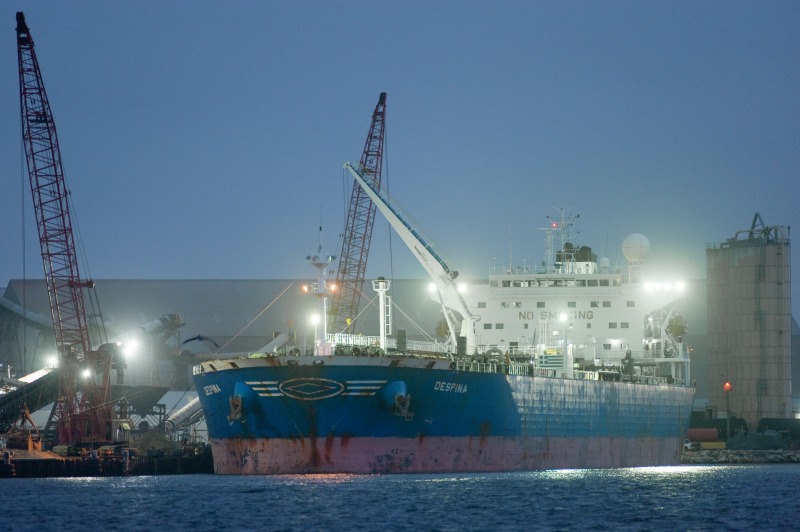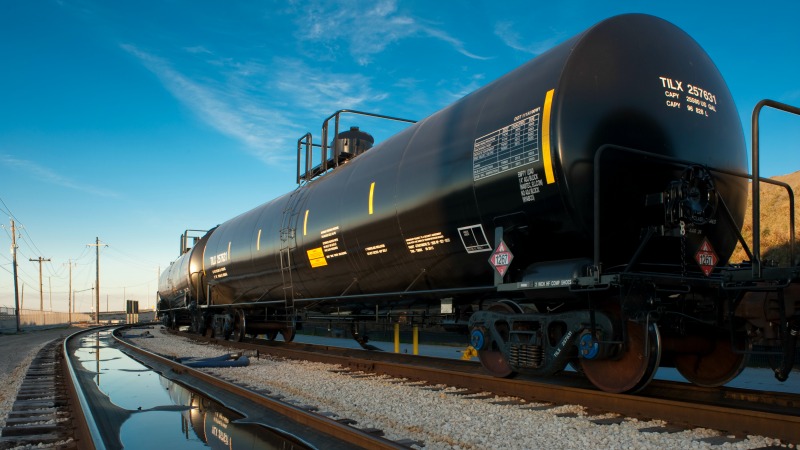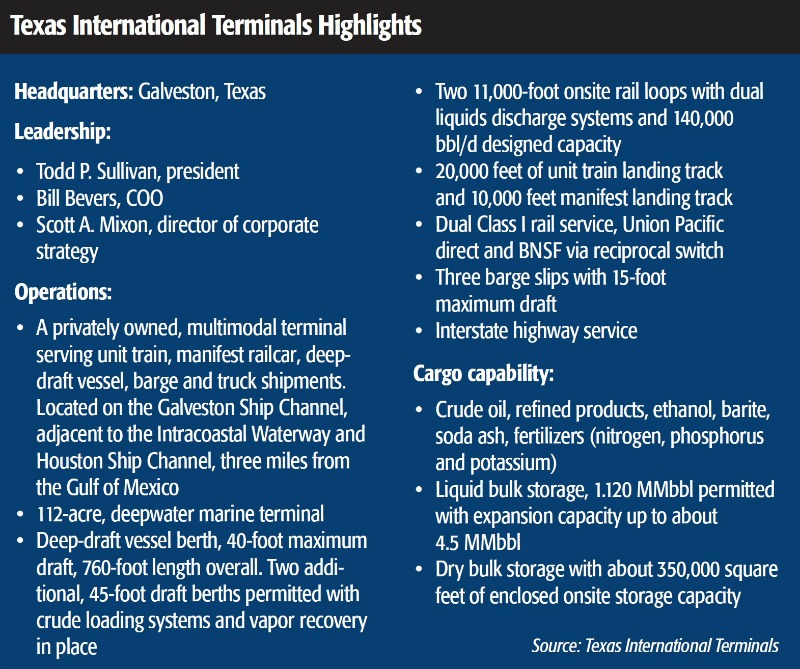
The City of Galveston lies in the distance behind a busy Texas International Terminals in the foreground. The operation’s Galveston Island location creates a hub for Gulf Coast crude and petroleum product traffic. All photos courtesy of Texas International Terminals Ltd.
Privately held Texas International Terminals Ltd. (TxIT) has a growing crude oil storage and shipping business—even though it works alongside industry giants on the Gulf Coast. A comparatively new midstream player, its Galveston, Texas, location offers customers a valuable hub linking multiple markets, according to its president.
MIDSTREAM: Your terminal is in the immediate vicinity of some other, big terminal players. How do you compete?
SULLIVAN: Our efficiency and our speed to market have kept Texas International Terminals competitive—even in this market filled with big players. As a private, 112-acre multimodal marine terminal located at Mile 3.5 of the Galveston Ship Channel, TxIT offers dual, unit train landing tracks with additional manifest landing tracks located on adjacent property. This rail infrastructure has capabilities to discharge dry bulk and crude oil trains of up to 135 cars within 12 to 14 hours, on the average.
TxIT’s deepwater berth is capable of loading up to Panamax-class vessels of liquid or dry bulk commodities for import or export. TxIT also offers three barge docks capable of accommodating inbound or outbound liquid cargo transfers in tandem barge sets. TxIT has received a permit from the U.S. Army Corps of Engineers to build two additional ship berths making the terminal capable of two Aframax-class vessels in addition to the Panamax berth and barge docks.
I like to say, Texas International Terminals is big enough to matter, small enough to care. We are nimble and capable of responding to changes in the market.
MIDSTREAM: You are involved in several other businesses. How does the terminal fit with them?
SULLIVAN: I’m extremely blessed to have two perfect partners, my two brothers, John and William Sullivan. We’ve always worked well together because each of us has unique strengths and capabilities that combine to make a great team.
Our business interests are quite varied. Rather than investing in equities, we’ve decided to develop a balanced portfolio of operating businesses. Each brother is in charge of a different division of our businesses. In our construction division, we are engaged in industrial and residential construction in three different markets—in Houston Heights, in Springwoods Village and on Galveston Island. Besides single-family and multifamily residential construction, we are also engaged in horizontal construction and land development.
Our services division is engaged in upstream energy field support services, as well as federal and state contracting. Finally, our industrial division, which includes Texas International Terminals, also includes a dredging and marine construction business with projects stretching from the eastern seaboard to the South Texas Gulf Coast.
MIDSTREAM: Describe how your terminal business has grown.
SULLIVAN: TxIT led the market in developing one of the first unit traincapable crude-by-rail facilities on the Texas Gulf Coast, commissioning our dual unit train rail loops during the second quarter of 2011. In the years since, we have increased our storage capacity and have received and handled just over 700 unit trains. TxIT is served by two Class I railways, Union Pacific directly and BNSF via reciprocal switch, which allows TxIT shippers and customers to have a fluid and efficient experience every time a train and/or manifest block arrives at the facility. With an average turn time for crude oil unit trains of 10 to 12 hours, TxIT’s customers and the Class I railroads’ expectations are frequently exceeded.
In addition to the domestic barrels arriving via rail, TxIT was also one of the first terminals on the Gulf Coast to receive and unload unit trains of Western Canadian Select crude originating in Alberta. With the decrease in overseas oil imports to the region, we continue to see growth potential in the Canadian bitumen streams and dilbit barrel—providing a highly desired feedstock to the Gulf Coast refinery complex.

Night falls as the Greek-flagged tanker Despina completes a call to Galveston.
To complement our rail infrastructure and handling capabilities, TxIT also has three barge docks for inbound and outbound movements, as well as one deep-draft, 40-feet, marine dock. The terminal’s deep-draft dock is Panamax-capable today and in the second quarter we received permits for the construction of two additional ship docks designed to accommodate a Panamax and an Aframax loading/discharging simultaneously. We believe that the addition of the Aframax-capable dock will be a tremendous addition to our suite of services both for import as well as export of crude oil and refined products.
In order to continue our pattern of growth and to provide full optionality to the market, TxIT has also commissioned engineering and right-of-way studies for the construction of both crude oil and refined products pipelines between our Galveston Island facility and the Texas City refining complex. We believe that this pipeline connectivity will be of tremendous value to the market—whether for imported or exported products.
MIDSTREAM: Who will provide the pipeline connection?
SULLIVAN: Our current design is to build to a point where we can interchange with all the pipeline operators in the Texas City area. Our objective is to provide an additional outlet for all the shippers on long-haul pipelines terminating in the area, Texas City/Houston, and for the area refineries seeking to improve efficiency for import/export movements of crude oil and refined products.
MIDSTREAM: Where is most of your crude coming from?
SULLIVAN: TxIT designed our unloading and handling system to accommodate a wide range of crude oils and condensates. As a result of this design flexibility, we routinely handle barrels out of West Texas, the Midcontinent and Rockies fields and have received and handled Canadian barrels down to approximately 15°API gravity and 700 centistokes.
MIDSTREAM: New petrochemical capacity is coming along the Gulf Coast—how will that impact your business?
SULLIVAN: The increase in market participants along the Gulf Coast will make being efficient in handling and services of utmost importance. Due to our location and experience, TxIT is well-positioned to stay ahead of this ever-changing environment. Having received and unloaded in excess of 700 unit trains since 2011, TxIT has an unparalleled reputation for service and efficiency among rail-to-marine facilities.
Further, TxIT’s pipeline expansion will afford our customers the added optionality of pipeline movements through our facility, and we anticipate an openseason offering for baseload commitments from shippers interested in the import/export of refined products and crude oil. With the addition of the recently permitted dock expansion project and planned pipeline connectivity to the Texas City/Houston refining complex, TxIT will be ideally situated as a base for import/export.
MIDSTREAM: How do your growth plans fit into the current North American midstream buildout?
SULLIVAN: Texas International Terminals will continue to benefit from the demands of the Gulf Coast refining markets by providing market participants available storage capacity and a full range of logistics opportunities—all outside of the congested Houston Ship Channel. We have a lot of land available for new capacity, we’re using about 30% of our land now.

The Galveston terminal was one of the first on the Gulf Coast to have full crude-by-rail capabilities.
My brothers and I are not the types that will go out and raise a bunch of capital and wastefully spend it. We tend to attract, or work with, customers that have a specific need and then build off of those needs. Again, we’re fairly conservative—we’re not going go out and overbuild ourselves and put ourselves in a financial burden.
MIDSTREAM: Have rail and marine transportation taken on new importance for producers?
SULLIVAN: Rail and barge movements have been the core of our crude business. Located near the geographic center of all the major markets along the Gulf Intracoastal Waterway, TxIT allows our customers broad optionality to serve virtually all refiners along the Gulf Coast. Now with the recent commissioning of our deep-draft marine berth’s crude loading system, and the permit in hand to begin construction of two additional Aframax-capable deep-draft marine berths, we will remain competitive offering full optionality for movements to and from domestic or foreign markets.
MIDSTREAM: Have you seen any change in product flow with new pipeline capacity to the Cushing, Okla., trading hub opening to the Gulf?
SULLIVAN: Absolutely. There is an abundance of crude moving into Houston from the newly commissioned pipelines linking Cushing to the Gulf Coast, as well as other pipelines originating in West Texas fields. Naturally, the availability of expipe barrels has had an impact on the crude-by-rail movements over the last six to 12 months. Although we are still seeing solid volumes of crude arriving via railcar, we see the combination of pipeline connectivity and our geographical location and proximity to blue water outside the Houston Ship Channel as being keys to TxIT’s growth in the coming years.
MIDSTREAM: You mentioned multiple refining and petrochemical centers around the Gulf Coast. How are these markets alike? How do they differ?
SULLIVAN: One would believe that due to their geographical proximity, these markets would act similarly. However in recent years, each of these refining centers has experienced basis dislocations, providing economic incentives for marketers, traders and refinery supply folks to move barrels around in non-traditional ways. This volatility is attributable to a number of factors including growth in crude production from fields in close proximity to a refining center, such as Eagle Ford-Corpus Christi [Texas], and a deluge of new or increased pipeline capacities; Houston-Port Arthur.
The constant change creates opportunity for terminals that are located and connected in such a way to react to market change. With our terminal being centrally located to all of these refining centers, our customers have had continued optionality.
MIDSTREAM: Do you do crude blending?
SULLIVAN: TxIT’s infrastructure allows for blending to customer specification. TxIT has circulation and mixing systems providing our customers the option of blending heavier barrels with light barrels to accommodate a specific blend for refiners. Refiners are constantly seeking to optimize their productivity by receiving different blends and grades—crude cocktails. We see custom blending as another potential area of growth.
With the wide variety of crude produced domestically and in Canada—including Eagle Ford, Niobrara, West Texas, MidCon and Canadian bitumen barrels—refiners will continue to dial-in their optimal blends and will continue to look to facilities like ours to make sure they are getting the right quality each time a feedstock shows up at the gates of the refinery.
MIDSTREAM: Is the lingering crude glut at Cushing simply becoming a Gulf glut?
SULLIVAN: It already has. With the increased pipeline capacity, we are definitely seeing an increase in supply on the Gulf. Having the ability to move barrels to the water will play an increasingly important role in reducing the oversupply by enabling shippers and refiners to move these barrels out to different markets. Shipments to the East Coast, West Coast, Louisiana, Beaumont/Port Arthur, all provide opportunity for moving barrels away for the over-supplied Houston/Texas City markets.
Taking it a step further, if policy changes allow for export of domestic crude and clarifications are issued relating to condensate export rules, TxIT’s efficient deepwater capabilities will be crucial in linking our customers to the global market for trade.
MIDSTREAM: The U.S. has become a net exporter of refined products and the first exports of processed condensate have begun. How has the export trend changed your operations?
SULLIVAN: We believe the processed condensate export is a major growth play for the U.S. We are currently seeking commitments for these movements as we provide optimal marine capabilities for the export of these barrels.
We have recently begun to examine the possibility of re-tooling onsite plant assets for use as a crude oil stabilizer, allowing TxIT customers the option to process compliant condensate for export. To provide producers and traders the optionality of bringing in railed, trucked or marine barrels, then stabilize the condensate, and put them back on a vessel for exports, would create a home for these discounted light barrels that does not exist today at a terminal on the Gulf Coast.
MIDSTREAM: How will the Panama Canal expansion impact you?
SULLIVAN: Along with the rest of the industry, we are closely watching the Panama Canal expansion project and see significant opportunity for growth as a result of projected increased vessel traffic. However, the more significant advantage to TxIT will likely come from the economies of scale of utilizing larger vessels for import/export movements. This potential was a big motivator for our dock expansion project to enable our facility to receive those wide-body Aframax class vessels for loading and unloading.
In addition, if the Houston Ship Channel sees the increase in vessel calls that many have predicted will happen post-Canal expansion, our proximity to blue water, lack of daylight restricted access and location outside the Ship Channel will be of even greater value to shippers looking to move refined products and crude oil over water in the most efficient manner.
MIDSTREAM: What happens if full, unrestricted crude exports become legal?
SULLIVAN: While I am not holding my breath for a rapid change, relief of the crude export ban would be a game changer for Gulf Coast logistics and pricing.
Clearly, lifting of the export ban would immediately relieve the glut of domestic production finding its way to the U.S. Gulf Coast. It would also help balance the world market for pricing given that the U.S. Gulf Coast is fairly independent of the global pricing benchmark, Brent.
From a terminal view, having uncongested deep-draft marine berths will be key. While the Houston Ship Channel no doubt provides many options, the congestion in the Houston Ship Channel will only get worse with the lifting of the export ban—not to mention the anticipated increase in vessel traffic upon commissioning of the Panama Canal expansion slated for completion during late 2015.

Paul Hart can be reached at pdhart@hartenergy.com or 713-260-6427.
Recommended Reading
Crescent Energy Closes $905MM Acquisition in Central Eagle Ford
2025-01-31 - Crescent Energy’s cash-and-stock acquisition of Carnelian Energy Capital Management-backed Ridgemar Energy includes potential contingency payments of up to $170 million through 2027.
Petro-Victory Buys Oil Fields in Brazil’s Potiguar Basin
2025-02-10 - Petro-Victory Energy is growing its footprint in Brazil’s onshore Potiguar Basin with 13 new blocks, the company said Feb. 10.
Apollo Funds Acquires NatGas Treatment Provider Bold Production Services
2025-02-12 - Funds managed by Apollo Global Management Inc. have acquired a majority interest in Bold Production Services LLC, a provider of natural gas treatment solutions.
Nabors Closes $370MM Parker Wellbore Acquisition
2025-03-12 - The acquisition of Parker Wellbore adds a large-scale, high performance tubular rental and repairs services operation in the Lower 48 and offshore U.S. to the Nabors portfolio.
VAALCO Acquires 70% Interest in Offshore Côte D’Ivoire Block
2025-03-03 - Vaalco Energy announced a farm-in of CI-705 Block offshore West Africa, which it will operate under the terms of an acquisition agreement.
Comments
Add new comment
This conversation is moderated according to Hart Energy community rules. Please read the rules before joining the discussion. If you’re experiencing any technical problems, please contact our customer care team.





